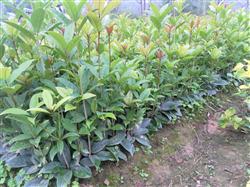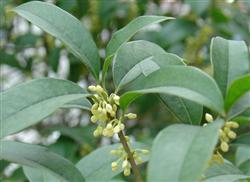How do sweet-scented osmanthus reproduce asexually?

How do sweet-scented osmanthus reproduce asexually? Please guide the four seasons sweet-scented osmanthus to be a small evergreen tree of the family Liliaceae. although its flowers are small, they are fragrant and can blossom continuously except for severe cold and extreme heat. They are of high ornamental and economic value. The four seasons sweet-scented osmanthus is produced in the southwest and central part of China, which is suitable for cultivation in various places and potted plants in the north. The branches of the four seasons are often propagated asexually, and the methods are as follows: (1) Cuttage. Just before spring sprouts. One-year-old sturdy branches were collected as panicles, each section was cut into about 10 cm long, and 2 green leaves were retained in the upper part. Dip the base of the cuttings in the solution of vitamin B12, or soak the cuttings in ABT2 rooting powder solution containing 50 mg per kilogram for 1 hour, then cut them in a sand table with a depth of 1 inch 2 cuttings. Place the cuttings in a shaded place to avoid direct sunlight, spray water to keep the cuttings moist, root cuttings after 15 days, and transplant or pot in 50 days. (2) grafting. The grafted seedlings have the advantages of fast growth, high survival rate and early flowering. Ligustrum lucidum or Ligustrum lucidum 1Mel-2-year-old seedlings were used as rootstocks, which were often grafted by cutting and bud grafting. (1) splicing: it should be carried out before germination in early spring. One-year-old strong branches are used as ear strips, each section is cut into about 10 cm long, and 3 buds are left at the top, cut at 0.5 cm above the bud, cut to the end at 4 cm from the bottom bud, the xylem needs to be removed for deep cutting, and a 0.5 cm long slope is cut at the opposite end of the cutting side. Cut at 6 cm above the ground of the rootstock, flatten the section, and cut vertically on one side of the section a section with the same depth as the length of the scion. The long cutting of the scion is inserted inward into the cut of the rootstock, and the cambium on one side of the two is relatively matched, and finally the interface is tied up with a plastic film belt. After the interface is healed and taped, the banding should be lifted and the shady tiller of the anvil should be erased. (2) Bud grafting: in summer. Use the strong branches with one-year-old bud eyes as ear strips, cut off the leaves to retain the petiole, and cut upward at 1.5 cm above the ear bud, with a depth of slightly xylem. Cut a knife across the rootstock 10 cm from the ground, and then make a vertical cut with the same length as the bud slice from the middle of the cut, so that the incision is in the shape of a "T" and its depth is even to the degree of the cambium. Then open the cut of the rootstock, insert the bud into the "T" mouth, and wrap the dew bud with a plastic bag. Remove the banding after budding and cut off the rootstock above the budding. (3) High pressure. It can be carried out in spring, summer and autumn. On the excellent plant, the robust branch of 2 Mel-3 years old was selected as the high pressure branch, and the high pressure position was made at the place where the high pressure branch was about 15 cm from the planting point. In the high pressure position, a circle of 6 cm wide cortex is annularly peeled, or the cortex is tapped with a small stick. It is appropriate to break the skin in high school without falling off, and then the nutritious soil can be wrapped after 4 days of drying. Use plastic film to surround 2 murmurs 3 times above the high pressure position to make it into a 25 cm long and 10 cm thick membrane tube, then tighten the lower end of the membrane tube with a rope at 5 cm below the high pressure position, then fill the membrane tube with culture soil (humus soil plus 20% humus manure), and compact it, and finally fasten the membrane tube with a rope at the upper end of the high pressure position to make it spherical. Use a syringe to inject water into the culture soil every week to keep it moist. 1 the wound of high-pressure branch can take root after 2 months, and then it can be cut off from the mother tree, removed the membrane, transplanted or put on the basin. Click to get more sweet-scented osmanthus planting techniques
- Prev

How to weed when growing organic vegetables?
How to weed when growing organic vegetables? The biggest headache in organic vegetable production is weed control. " The vegetable farmer of the organic vegetable base said helplessly. Because organic vegetables are not allowed to use synthetic pesticides, fertilizers, herbicides and growth regulators in the cultivation process.
- Next

How to control common pests
How does osmanthus prevent common pests? There are several kinds of diseases and insect pests of osmanthus fragrans: 1. Leaf spot disease: mainly harmful to leaves, primary brown spots, round or irregular spots, late central gray to grayish white, reddish-brown edges, black-gray mold on spots. High temperature and humidity are often the cause of disease.
Related
- Fuxing push coffee new agricultural production and marketing class: lack of small-scale processing plants
- Jujube rice field leisure farm deep ploughing Yilan for five years to create a space for organic food and play
- Nongyu Farm-A trial of organic papaya for brave women with advanced technology
- Four points for attention in the prevention and control of diseases and insect pests of edible fungi
- How to add nutrient solution to Edible Fungi
- Is there any good way to control edible fungus mites?
- Open Inoculation Technology of Edible Fungi
- Is there any clever way to use fertilizer for edible fungus in winter?
- What agents are used to kill the pathogens of edible fungi in the mushroom shed?
- Rapid drying of Edible Fungi

